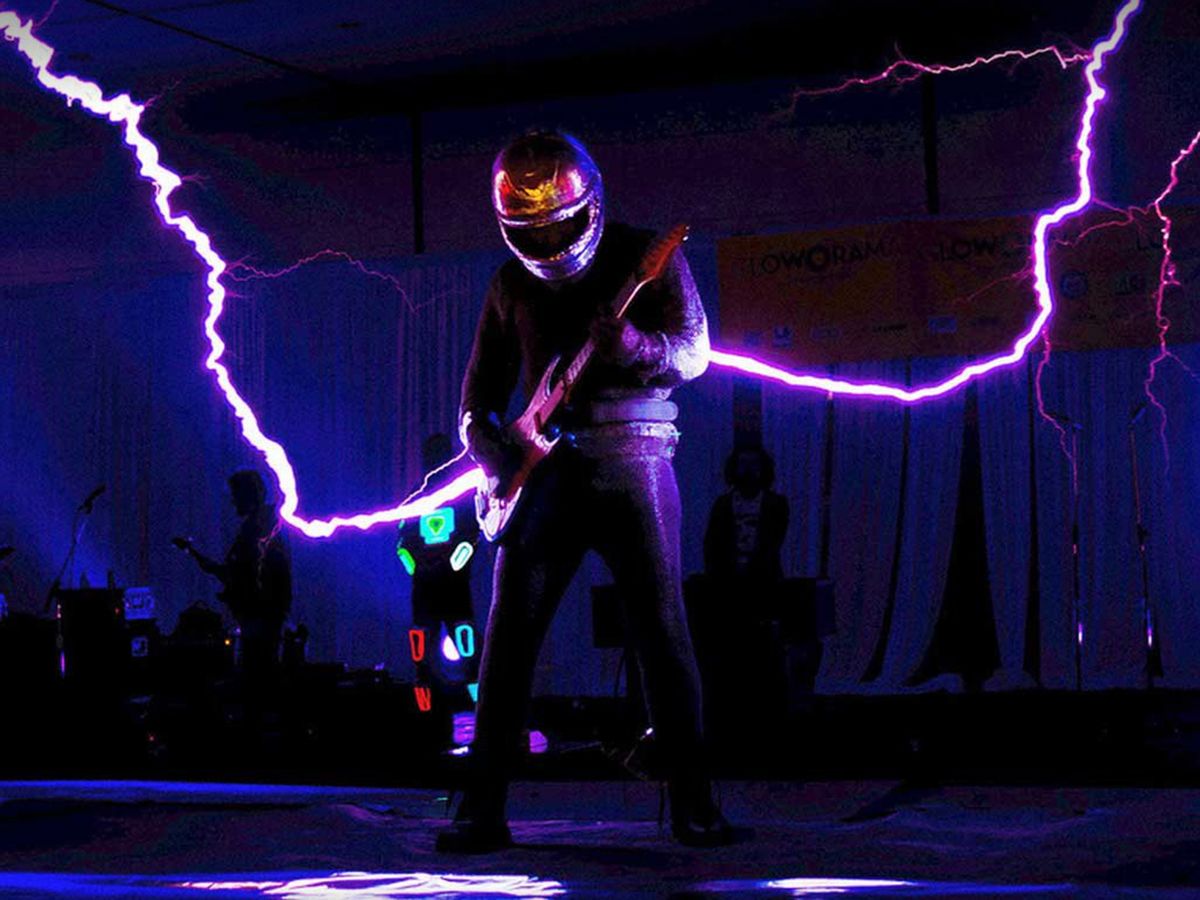If you’ve ever wanted to play guitar while giant bolts of lightning ground themselves around you—andtoyou—then Joe DiPrima can hook you up. DiPrima is the cofounder of ArcAttack, a small Austin, Texas–based performance and design group that specializes in the fun things you can do with high-voltage Tesla coils.
“We do a lot of random things,” says DiPrima, with a chuckle, “Every year we go on a fall and spring tour, usually. We’ll go into theaters and schools and do an hour-long science show, and then we do lot of public shows in conjunction with those.”
To get a flavor of ArcAttack’s shows, you can visit the group’s YouTube channel and see and hear how they play music through so-called singing Tesla coils, in which the long sparks from a coil are modulated at audible frequencies by square waves. The result is spectacular, if perhaps not terribly melodious. DiPrima sometimes wears a suit that is a full-body Faraday cage, allowing him to play a special guitar while being struck by bolts from two giant Tesla coils.
DiPrima also designs and builds Tesla-coil demonstration systems for museums and the like: “We have a system at the Orlando Science Center [in Florida], and the Rochester Science Center [in New York], and the Liberty Science Center in New Jersey,” says DiPrima.
Most recently, DiPrima and his brother (and ArcAttack cofounder) John worked for fashion-tech designer Anouk Wipprecht and bionic pop artist Viktoria Modesta to create a hollow prosthetic leg for Modesta that was fitted with spark gaps, for a car commercial. Driving the spark gaps required fabricating a miniature Tesla coil that could be fitted into the heel of a customized shoe.
DiPrima doesn’t have a formal engineering education. “I was interested in electronics by the time I was very young. My dad helped me—he was a biomedical technician, so I got experience doing [things] like soldering,” says DiPrima. In his teens DiPrima “put down electronics for a bit and got into computers because it was the ’90s—all the cool stuff was happening with computers at the time...just writing programs purely for my own pleasure, when I was supposed to be doing my schoolwork!”
When he finished high school, DiPrima took a job repairing televisions and other consumer electronics, which turned out to be an education in itself. “You get to see how everybody screwed up. I think it’s a pretty invaluable lesson. You know what RCA did wrong.... You know what Samsung got wrong every time.... Things are super-refined now, but back in the day everything had some peculiar glitch or problem.”
When the TV repair business dried up because it became cheaper to replace a TV than fix one, DiPrima worked at a music store repairing guitar amplifiers—“people will still pay $150 to repair a $900 Marshall amp,” he says—before getting a job around 2005 at the University of Texas doing work like designing and building lecterns in classrooms.
That’s when he and his brother got interested in Tesla coils. “We started building our own Tesla coils for the sole purpose that we wanted them to be musical instruments. We posted some as a kind of a hobby.” The videos started attracting an audience and the brothers started performing live shows. Eventually, they realized they were making more money doing things like selling T-shirts at their shows than they were earning from their day jobs, and they took the plunge and formed ArcAttack as a full-time occupation.
DiPrima continues to spend a lot of his time reading and researching for his projects. “I kind of regret now that I didn’t have more college education, but at the same time I feel like I have a pretty solid foundation of engineering knowledge,” he says.
This article appears in the May 2019 print issue as “Joe DiPrima.”
